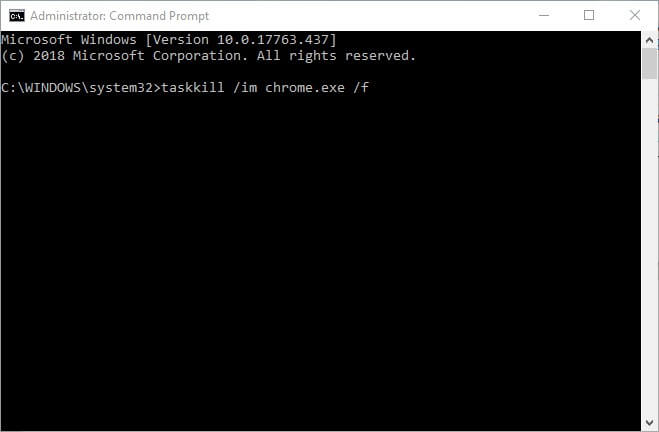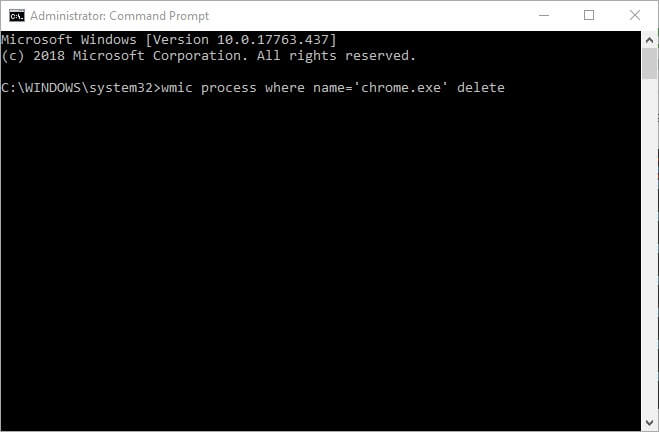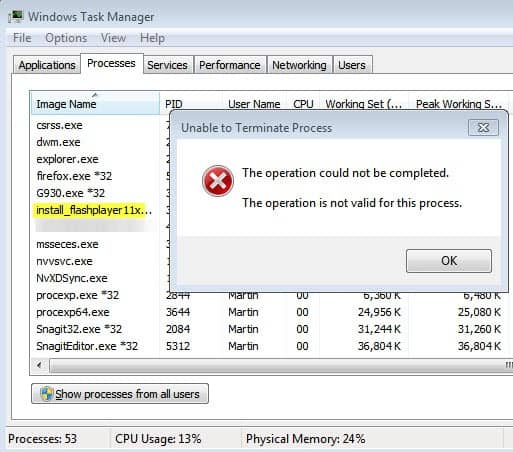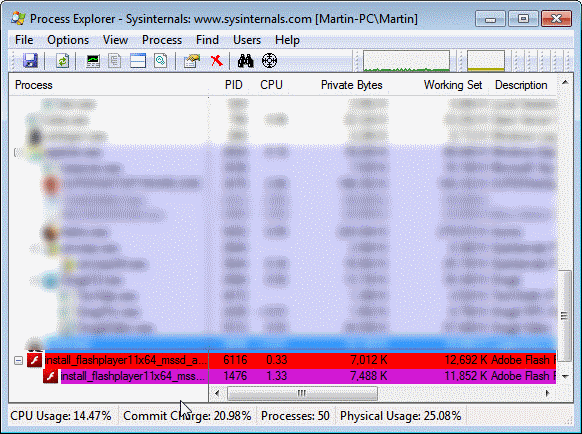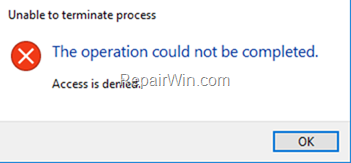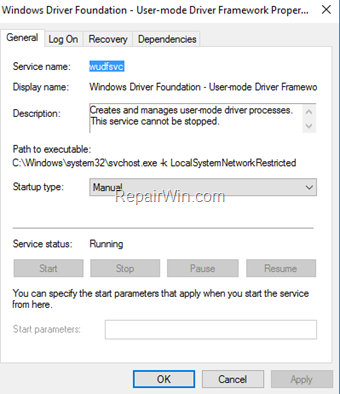unable to terminate system idle process pid 0 указан неверный код клиента
How to terminate System Idle Process?
Every time i start my windows 7, the CPU gets very high, up to 60% and i haven’t opened nothing yet.
I opened task manager and saw what process where using the most. In the CPU usage and i found that System Idle Process had 67% of CPU usage.
After that i tried to kill that process but it showed me this.
How can i solve this problem?
1 Answer 1
How do I terminate System Idle Process?
You cannot kill the System Idle process. The real question is why would you want to?
System Idle is the process that runs when the computer has absolutely nothing better to do (in other words it is waiting for some other process to need more CPU resources).
What is the System Idle Process and why is it using most of the CPU?
I mean, really, a process that regularly takes up 99% of your CPU’s time must be a bad thing, right?
Nope, not at all. Just the opposite, in this case.
The fact is that most computers can never really do nothing. When the computer is on, the CPU’s running and it must do something – even if that “something” is waiting for something real to do.
Think of it as your computer just twiddling its virtual thumbs, waiting for something more important to do. The computer’s doing something (virtual thumb twiddling), but we wouldn’t call that doing anything useful.
That’s called being idle.
And the “System Idle Process” is the software that runs when the computer has absolutely nothing better to do.
It effectively runs at the lowest possible priority so that if anything, anything at all, comes along for the CPU to work on, it can. When there’s nothing left to do, back to idle it goes.
So having the System Idle Process using 90% of your CPU is a good thing … it means that that 90% is readily availble should there be any real work to do.
System Idle Process постоянно грузит процессор – что делать?
Во время простоя нагрузка на компоненты компьютера должны быть минимальна. Если вы не запустили ни одной программы, не поставили скачиваться файлы, а процессор уже загружен на полную – что-то в системе работает неверно. Разберемся с ситуацией, когда System idle process все время грузит процессор – что это за утилита и как ее отключить.
Что такое System Idle Process
Если компьютер тормозит, откройте «Диспетчер задач», нажав Win+X и выбрав одноименную утилиту. На первой вкладке приведен перечень выполняющихся процессов, кликните на столбец ЦП, чтобы отсортировать их по убыванию нагрузки на центральный процессор. На первой строке окажется главный виновник загрузки системы, иногда это System Idle Process или утилита «Бездействие системы» в русскоязычных версиях Windows.
System Idle Process – что же это такое? Это специальный процесс бездействия, но он не показывает процент простоя процессора. В Windows существует специальная утилита, которую ОС запускает в то время, когда компьютер не нагружен другими операциями. System Idle Process помогает снизить потребление энергии и температуру процессора, выполняя в цикле процедуру приостановки.
Во время остановки ЦП постоянно ожидает появления какого-либо прерывания – как только появится какая-нибудь задача, компьютер сразу проснется. Утилита бездействия имеет наименьший приоритет среди всех других, она не стартует, пока есть хоть один другой процесс для запуска.
Поэтому проценты у System Idle Process в диспетчере показывают не загруженность компьютера, а количество свободных ресурсов.
Как отключить процесс
Отключить системный System Idle Process нельзя. Если вы кликните по нему правой кнопкой мышки, то в подменю будут недоступны стандартные операции «Снять задачу» или «Задать приоритет». Утилита обращается к ядру ОС, поэтому в Windows запрещено давать пользователям возможности управления такими системными процессами.
Как снизить нагрузку на процессор
В нормально работающей системе System Idle Process совсем не снижает быстродействие. Если же при больших показателях бездействия процессора в 60-70% компьютер заметно тормозит, надо искать причину. Проверьте в «Диспетчере задач», что вызывает повышенную нагрузку на ЦП. Также можно использовать «Мониторинг ресурсов»: зажмите Win+R и впишите resmon. Сервис покажет более подробную информацию по использованию ресурсов ЦП.
Часто нагрузку вызывают «Системные прерывания» — те самые, которые должны отслеживать возникновение запросов к ПК во время бездействия. Если они занимают больше 10% ресурсов, проделайте следующее:
Заключение
Мы разобрались, что означает загрузка системы процессом System Idle Process и как от него избавиться. В норме утилита понижает энергопотребление во время простоя ПК и не нагружает его ресурсы. Если компьютер работает медленно – ищите другие причины проблемы.
Unable to terminate process error in Windows 10 [FIX]
Users can usually close the software and other processes by clicking Task Manger’s End task button in Windows. However, Task Manager doesn’t always terminate processes. Some users have stated that an “Unable to terminate process” error message window pops up when they try to terminate certain processes. The error message states: “The operation could not be completed. Access is denied.”
Task Manager doesn’t terminate the required process when that error arises. Consequently, users can’t close unresponsive software or other service processes with Task Manager when the “Unable to terminate process” error message pops up. Nevertheless, there are a few other ways that users can potentially terminate the process for an unresponsive program.
How do I fix the Unable to Terminate Process Error
1. Press the Alt + F4 Key
Alt + F4 is a handy keyboard shortcut for closing unresponsive programs. Try pressing the Alt + F4 hotkey to force quit an unresponsive program when you can’t close it with Task Manager. Then users might not need to select the program’s process in Task Manager.
2. Switch to an Admin Account
Some users might need elevated rights to quit certain Task Manager processes. Thus, those users will need to switch to an admin account before they can terminate the process. Users can switch to the built-in Windows 10 admin account as follows.
3. Terminate the Process With Taskkill
There are a few Command Prompt commands that might terminate a process when Task Manager doesn’t. Users can try terminating the process with taskill instead. Open the Command Prompt as admin as outlined above.
Then enter ‘taskkill /im process-name /f’ in the Prompt’s window, and press the Return key. However, users will need to replace ‘process-name’ with the actual process name listed in Task Manager. To find the process detail, right-click the app or background process listed in Task Manager and select Go to details, which will open the tab shown in the snapshot directly below. Replace ‘process-name’ with the process listed on that tab.
4. Terminate the Process With WMIC
Alternatively, a Windows Management Instrument Console (WMIC) command might terminate the required process. Enter ‘wmic process where name=‘myprocessname.exe’ delete’ in an elevated Command Prompt, and press the Return key. Users will need to replace ‘myprocessname.exe’ with the actual process by checking the Details tab for it much the same as required for the taskill command.
5. Check Out Alternative Task Managers
There are numerous third-party Task Manager alternatives that might terminate the process for which the “Unable to terminate process” error occurs. Some third-party task manager utilities display more extensive system details and include more options. Process Hacker, System Explorer, and Process Explorer are among the more notable alternatives to Task Manager that might terminate the required process when TM doesn’t.
So, there’s more than one way to terminate software and services in Windows. When the “Unable to terminate process” error arises, try closing the required process with the Alt + F4 hotkey, Command Prompt commands, or third-party software as outlined above.
RELATED ARTICLES TO CHECK OUT:
Restoro has been downloaded by 0 readers this month.
Unable to Terminate Process, Windows Task Manager Alternatives
Today I tried to install the Adobe Flash Plugin for Microsoft’s Internet Explorer. The basic idea was to download the executable, run it and have Flash installed. The problem was that somehow the whole process got corrupted which had several consequences. The Flash Player installation running in the background was creating new temporary Flash executables in the temporary cache directory. When I tried to terminate the process via Windows Task Manager I received the message that access was denied. This happened with the online installer. I received the message «Unable to Terminate Process The operation could not be completed The operation is not valid for this process».
I’m not sure what caused the issue, but what I did know was that I had to stop the installer from creating new Flash installer instances on my computer. With Windows Task Manager out of the picture, I had to find a way to terminate the process.
One of the best Windows Task Manager alternatives is Process Explorer from Sysinternals (which have been part of Microsoft for the past years). You can download the latest version of Process Explorer from here.
I started the process manager with standard rights first only to find out that I could not use it this way to terminate the process. After exiting and restarting it with elevated rights (by right-clicking and selecting run as administrator) I was able to terminate the process on the system.
Other programs, like Process Lasso, Kill Process or the recently reviewed Daphne may have also been able to terminate the rogue process.
I have learned two things this morning: First, that Windows Task Manager is not almighty when it comes to terminating processes on Windows, and second that it is definitely better to download and install Adobe Flash Player offline installers.
Did you ever encounter a process that you could not kill? What did you do to resolve it?
FIX: Unable to terminate process. The operation could not be completed, Access is denied.
If you cannot terminate a process or service in Windows, because you ‘re getting the error «Unable to terminate process. The operation could not be completed, Access is denied», then continue reading below, to learn how to fix the problem.
The usual way to stop a running process in Windows is to open Task Manager, right-click the process name, and select ‘End Task’. But, as you may know, sometimes is impossible to stop a process because you receive the message «Unable to terminate process. Access is denied».
Similarly, you may experience a similar problem if you want to stop a service and you cannot, because the «Stop» option is greyed out, or because you receive the error «Unable to stop service. Access is denied» when trying to stop the service.
In this tutorial you ‘ll learn how to terminate any services or processes that you cannot terminate by using the usual ways.
How to Force Stop any Service or Program from PowerShell in Windows 10/8/7 OS.
Part 1. How to Terminate an Application from PowerShell.
1. Open PowerShell as Administrator.
2. In PowerShell, type the the following command to get the process ID (PID).
3. Note the name of the application that you want to delete and then type the following command to close all the instances of the application. *
TIP: If you want to terminate a single instance of a program, type the following command:
* Note: At PID type the unique number of the program instance.
Part 2. How to Terminate a Service from PowerShell.
1. Open the task manager and from the Services tab, notice the PID of the service that you want to stop.
e.g. In this example we are going to force stop the «AdobeARMservice» service with PID 1640.
2. Then, run PowerShell as administrator and type this command:
* Note: As PID type the PID you noticed in Task Manager. In this example the command will be:
That’s all folks! Did it work for you?
Please leave a comment in the comment section below or even better: like and share this blog post in the social networks to help spread the word about this solution.



